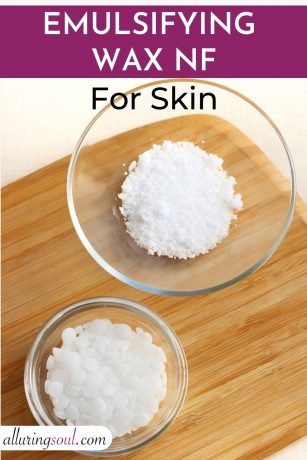Acting as a very good humectant, the reason why sodium lactate is used in body products is because of its ability to attract and retain moisture on the skin. Being a natural buffer and Natural Moisturizing Factor (NMF), sodium lactate is beneficial for maintaining healthy and hydrated skin. Check any lotion or body cream that you own. One of the primary components of these products is sodium lactate.
Let’s learn more about what sodium lactate is, its benefits, and how to use it in skincare.
What Is Sodium Lactate?
As evident from the name, sodium lactate is the sodium salt of lactic acid. It is obtained by fermenting sugars obtained from cornstarch and other natural sources of lactic acid. Sodium lactate also occurs naturally in our skin. It has an excellent water retaining capability and occurs as a part of our skin’s Natural Moisturising Factor (NMF).
Appearance – Sodium lactate appears as a white powder, while a 60% solution of it looks like a thin liquid.
Solubility – Sodium lactate is soluble in water and is added in the water phase of the formulation. Generally, the usage rate of sodium lactate varies from one product to another.
Usage Rate – Sodium lactate can be at 0.5% – 5% of the final weight of the formulation.
Sodium lactate is rich in electrolytes, it doesn’t play well with electrolyte-sensitive emulsifiers and thickeners. This means that you cannot incorporate sodium lactate in any lotion or product that is sensitive to electrolytes and can induce a negative reaction.
What Are The Benefits Of Sodium Lactate For Skin And Hair?
The benefits of using sodium lactate on skin and hair are as follows:
- The primary function of sodium lactate is as a humectant. It attracts moisture from the atmosphere and replenishes trans-epidermal water loss (TEWL).
- The moisturizing ability of sodium lactate is especially helpful for those with dry skin. Sodium lactate prevents the stratum corneum, or the upper layer of skin from getting dehydrated, and improves the moisture content by 84%.
- Another advantage of sodium lactate is that it acts as a pH regulator. By controlling the pH, it can regulate the acidity and alkalinity of the skin. The pH of sodium lactate ranges from 7.5 to 9. This mimics the pH of normal skin and prevents it from becoming too acidic or acne-prone.
- Sodium lactate also has some preservation abilities. Although it cannot work as a standalone preservative, it can enhance the action of other preservatives. Thus it prevents bacterial outgrowth on cosmetics and increases their shelf life.
Sodium Lactate vs Glycerine: Which Is Better For Skin And Hair?
Both sodium lactate and glycerine are used for the same purpose in skincare: To absorb and retain moisture. Although both these products are humectants, their water retaining abilities are different. Sodium lactate ranks above glycerin in its capacity as a humectant. Sodium lactate is a stronger humectant than glycerin, with over twice the water-holding capability.
There is a downside to using glycerine in creams and lotions. Glycerine is extremely sticky in nature. Thus by using glycerine, your final product can turn out to be very greasy on the skin. If you are looking for a hydrating moisturizer that will not feel sticky on your body, then sodium lactate is the answer for you.
Is sodium Lactate Good For Your Hair?
Yes, sodium lactate is good for hair. It does not make the hair sticky. Instead by drawing moisture, it hydrates the strands of hair. It also helps in epidermal lipid synthesis, thus protecting the scalp and moisturizing it.
Is Sodium Lactate A Preservative?
No, sodium lactate is not a preservative. Instead, it enhances the action of other preservatives.
The main task of a preservative is to kill the bacteria that might contaminate cosmetic products. Although sodium lactate cannot kill bacteria, it can inhibit their reproductive processes, thus improving the functionality of other preservatives.
Is sodium Lactate Safe For The Face?
Yes, sodium lactate is safe for application on the face. Being a part of the skin’s Natural Moisturising Factor (NMF), it can hydrate the skin well, regulate acidity levels and promote healthy skin. However, a concentration of more than 3% sodium lactate can increase sensitivity to the sun. Thus, it is important to check the amount of sodium lactate being used in skincare products, before applying them to the face.
Is Sodium Lactate natural?
Yes, sodium lactate is a natural humectant. It is obtained from the fermentation of lactic acid obtained from natural sources.
Are Sodium Lactate And Lactic Acid The Same?
No, sodium lactate and lactic acid are not the same. Although the terms sodium lactate and lactic acid might be used interchangeably in skin care, these are two different products. Lactic acid is an alpha-hydroxy acid (AHA) while sodium lactate is formed through the neutralization of lactic acid.
Sodium lactate is used as a humectant in skincare. It can attract moisture very well and keep the skin hydrated. It also acts as a pH regulator and balances the acid levels on our skin. On the other hand, lactic acid is useful to accelerate the process of cell turnover. It can exfoliate dead skin cells from the top layer and make the skin firm and smooth.
What Is The pH Of Sodium Lactate?
Sodium lactate is used as a pH regulator in lotions. The pH of a 60% sodium lactate solution ranges from 7.5 to 9. This ensures that sodium lactate will not affect the normal pH of the skin.
Is Sodium Lactate Vegan?
Yes, sodium lactate is a vegan product. The major source of sodium lactate is the fermentation of lactic acid present in beet and cornstarch. This makes sodium lactate a fully vegan product.
Can I Use Sodium Lactate In Lotion?
Yes, you can use sodium lactate in lotion. The usage rate typically varies from 0.5 to 3%.
Being a natural humectant, sodium lactate attracts moisture to the skin. When used in lotions and body creams, it can moisturize the skin without feeling too sticky.
Can I Use Sodium Lactate In Hair Conditioners And Shampoos?
Yes, sodium lactate can be used in hair conditioners and shampoos. Generally, not more than 5% of sodium lactate is required to be used in hair care products.
Sodium lactate is a good humectant and can hydrate the scalp very well. By using sodium lactate in leave-in or rinse-off products, you can improve the elasticity of hair strands and prevent any bacterial growth on the hair follicles.
What Are The Side Effects Of Sodium Lactate?
Generally, sodium lactate is found to have no side effects. However, it is not recommended to be used on infants. A concentration of more than 3% sodium lactate can make the skin sensitive to the sun.
Can Lactose Intolerants Apply Sodium Lactate To Their Skin And Hair?
Yes, sodium lactate can be used by lactose intolerants. Although the term sodium lactate sounds similar to the milk sugar called lactose, the two products are quite different. Sodium lactate is not chemically related to lactose. It is obtained from cornstarch or beet, by neutralizing the lactic acid with sodium. This means that even lactose-intolerant people who are allergic to milk proteins can use sodium lactate products to skin and hair.
What Is The Substitute For Sodium Lactate?
The substitutes for sodium lactate are:
- Glycerine – The best substitute for sodium lactate is glycerine. Known for its supreme moisturizing ability, glycerine also adds moisture to the skin. However, glycerine is very sticky in nature. Using more than 2% glycerine in skincare products can lead to a greasy formulation that feels heavy on the skin.
- Panthenol – Panthenol is another useful substitute for sodium lactate. It is a form of vitamin B5. Besides delivering moisture to your skin and keeping it hydrated, panthenol also helps in repairing skin wounds and acne. Panthenol can also be used to treat redness, irritation, and inflammation.
- Sodium PCA – Sodium PCA is the sodium salt of pyroglutamic acid. It forms the base of all protein structures in our body. Like sodium lactate, sodium PCA is also a good humectant. Besides attracting moisture, it has anti-aging properties, reduces inflammation, and can regenerate the skin barrier.






No Comments